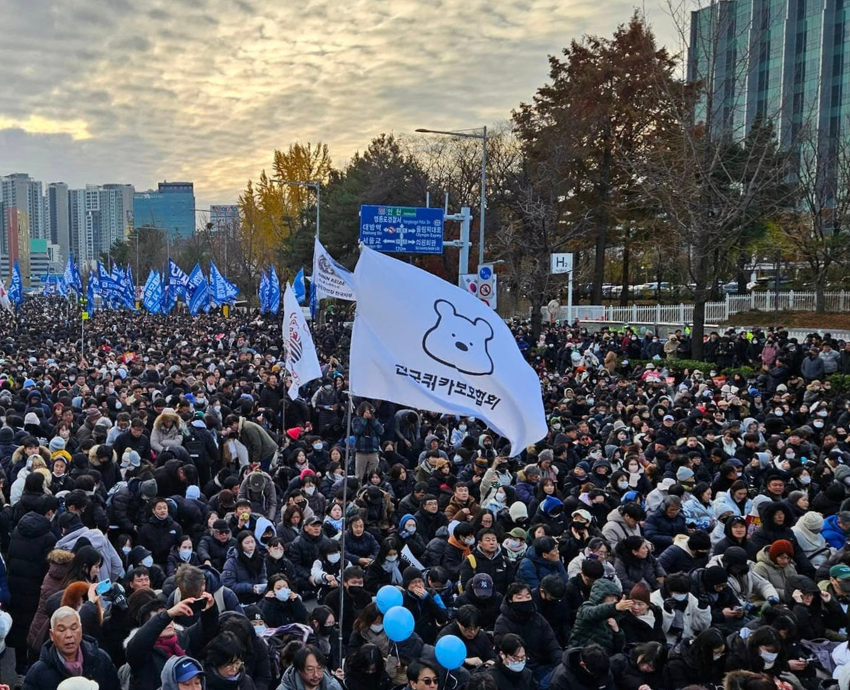
The rapid mass response to South Korea president Yoon Suk-yeol’s declaration of martial law, which stopped the president’s coup in its tracks, is explained by South Korea’s history of military regimes.
Korea became a Japanese colony in 1910. The Japanese World War II occupation was brutal. There was resistance organised by communists, leftists and others.
When Japan was defeated in August 1945, people’s committees briefly sprang up in the Korean peninsula and a provisional government formed.
The United States military invaded Korea in September from the south, and set up a US military government, and the committees and provisional government there were abolished.
The Soviet Union, which was allied with the US in WWII, invaded from the north. The result was a division of Korea, between the Soviet-dominated north and the US-dominated south, along the 38th parallel.
The US bombing of the Japanese cities of Hiroshima and Nagasaki in August 1945 and the Cold War with the Soviet Union hardened the division between what became North and South Korea.
The US military government built up the South Korean army formed under the Japanese, and established the Republic of Korea (South Korea) as an anti-communist bastion in 1948. Its first president, Syngman Rhee, imposed martial law to crack down on communists and other left forces.
In the north, the USSR installed a government with the Korean communists, along Stalinist lines, built up the North Korean army, and withdrew its own troops before the Korean War began in 1950.
US troops have remained in South Korea since 1945 — about 29,000 are stationed there today. The US has dominated South Korea since.
North Korean troops entered South Korea, in June 1950, in a bid to reunite the two. The result was the Korean War. Under the flag of the United Nations, the US armed forces fought North Korea.
The momentous Chinese Revolution took place in 1949, which alarmed the US. In response, the US sought to extend the Korean War into an attack on China. US forces swept into North Korea up to the Yalu River — the Chinese border. China responded by sending its troops into North Korea, and fought the US. The war raged on for three years, and left about two million dead, until an armistice was signed in 1953, with the 38th parallel again the dividing line. There has been no official end to the war.
In South Korea, the anticommunist Rhee regime used the war to consolidate a monopoly on political power.
After the war’s end, his authoritarian rule was characterised by corruption and repression.
Protests broke out against electoral corruption in 1960, launching the April Revolution. Rhee imposed martial law, but protests mounted until he was pressured by the US to step down.
The National Assembly then elected Yun Bo-seaon, from Rhee’s party, as president.
A military coup occurred in May 1961, when army officer Park Chung-hee led thousands of troops into the capital, Seoul. Yun was deposed, but became a figurehead of the new regime for a time.
Park was part of the Korean army under the Japanese, and was trained by them and then by the US.
The US quickly announced its support of the military regime. Park set up the Korean Central Intelligence Agency, which would be his power base, and became president in 1963. Park would declare martial law from time to time, to suppress dissent.
Park was assassinated in 1979. Initially, Choi Kyu-hah of Rhee’s party rose to the top, but he was deposed in another military coup in 1980, and military leader Chun Doo-hwan took power. This led to an uprising in the southern city of Gwangju. Hundreds of protesters were killed in a crackdown by security forces.
His regime lasted until 1988. Chun’s rule was characterised by brutality and repression.
In the Western media, it is often claimed that democratic rule was established in 1980, ignoring Chun’s record. The first directly elected president was Ron Tae-woo in 1988. Chun was charged with mutiny and treason and sentenced to death in 1995, but was subsequently pardoned.
The South Korean masses clearly do not want a return to military rule, repression, killings and imprisonments.